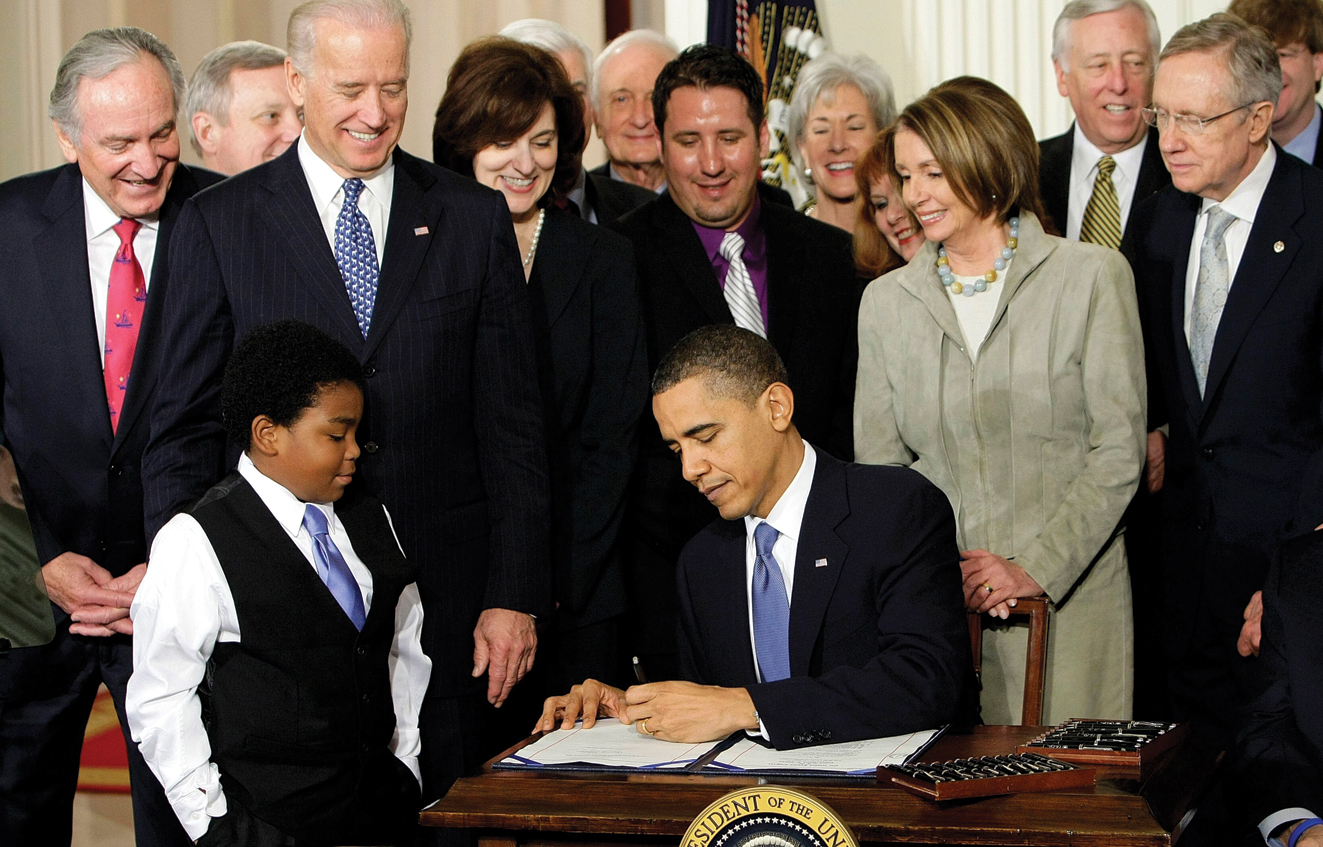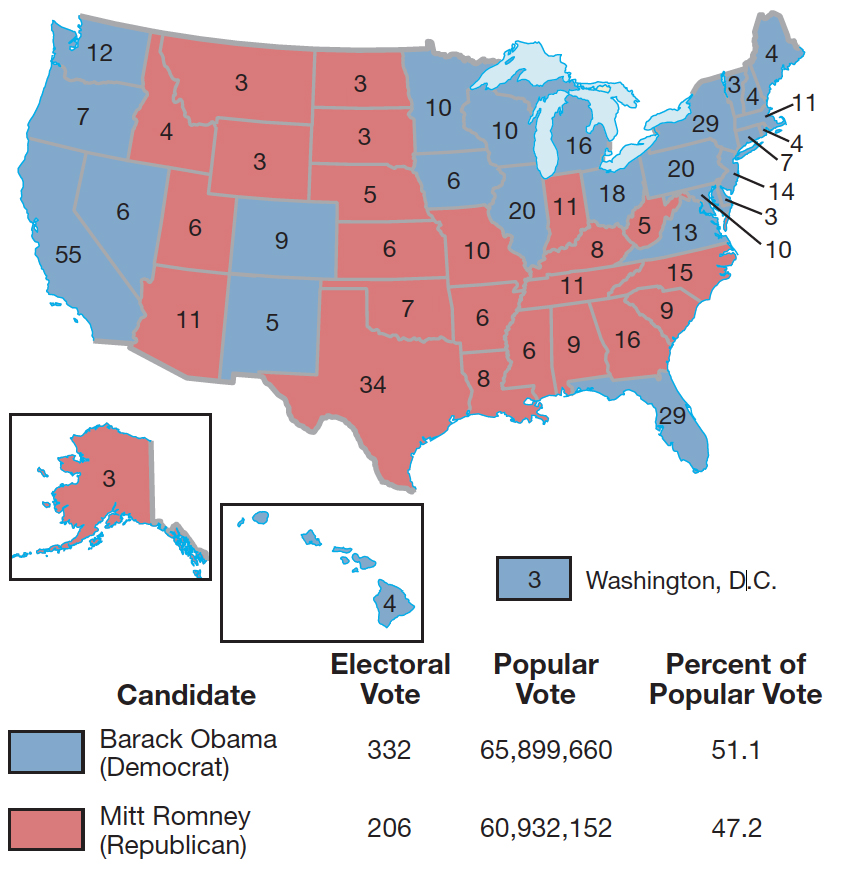The Obama Presidency: Reform and Backlash
Printed Page 875 Chapter Chronology
The Obama Presidency: Reform and Backlash
ESSENTIAL QUESTION
What obstacles stood in the way of Obama's reform agenda?
Despite the improving situation in Iraq, President Bush's approval ratings sank on the eve of the 2008 elections. The Republicans nominated Senator John McCain of Arizona, a Vietnam War hero, who chose as his running mate Alaska governor Sarah Palin, the second woman to run for vice president on a major party ticket. Even more historic changes occurred in the Democratic Party when, for the first time, an African American and a woman were the top two contenders. (See "Visualizing History.") In hard-fought primary battles, Barack Obama edged out New York senator and former First Lady Hillary Clinton for the nomination.
Born to a white mother and a Kenyan father and raised in Hawai'i and Indonesia, Obama served in the Illinois Senate and in 2004 won election to the U.S. Senate. At the age of forty-seven, he won the Democratic nomination with brilliant grassroots and Internet organizing and by appealing to deep-seated longings for a new kind of politics and racial reconciliation. He won 53 percent of the popular vote and defeated McCain 365 to 173 in the electoral college to become the first African American president, while Democrats increased their majorities in the House and Senate.
Obama hoped to work across party lines as he pursued reforms in health care, education, the environment, and immigration policy, but he confronted a severe economic crisis. A recession had struck in late 2007, fueled by a breakdown in financial institutions that had accumulated trillions of dollars of bad debt, much of it from risky home mortgages. As the recession spread to other parts of the world, home mortgage foreclosures skyrocketed, major companies went bankrupt, and unemployment rose to 9.8 percent in late 2010, the highest rate in more than twenty-five years.
The crisis was so severe that Congress passed the Bush administration's $700 billion Troubled Asset Relief Program in 2008 to inject credit into the economy and shore up banks as well as other businesses. Obama followed with the American Recovery and Reinvestment Act of 2009, $787 billion worth of spending and tax cuts to stimulate the economy and relieve unemployment. He also arranged a federal bailout of General Motors and Chrysler, saving an estimated one million jobs related to the automobile industry. Finally, to address the conditions that triggered the financial crisis, Congress expanded governmental regulation with the Wall Street Reform and Consumer Protection Act in 2010.
Obama's judicial appointments increased the number of women on the Supreme Court to three and included the first ever Latina justice. His greatest domestic achievement was the passage of health care reform. The Patient Protection and Affordable Care Act of 2010 required that nearly everyone carry health insurance, and to that end, it provided subsidies and compelled larger businesses to offer coverage to employees. The law also imposed new regulations on insurance companies to protect their customers and contained provisions to limit health care costs. Although liberals failed to get a public option to allow government-managed programs to compete with private insurance plans, the law represented the largest expansion of government since the Great Society. Republicans had previously endorsed key elements of the measure, but not a single one voted for it. In the face of widespread opposition to what critics called "Obamacare," the Supreme Court upheld its constitutionality by a 5–4 vote, as the United States became the last of the industrial democracies to underwrite health care for all its citizens.
Patient Protection and Affordable Care Act
Sweeping 2010 health care reform bill that established nearly universal health insurance by providing subsidies and compelling larger businesses to offer coverage to employees. Championed by President Obama, it also imposed new regulations on insurance companies and contained provisions to limit health care costs.

In foreign affairs, Obama reached out to Muslim nations, recommitted the United States to multilateralism, and worked to contain the proliferation of nuclear weapons. He continued the Bush administration's plan to withdraw from Iraq, and the last troops departed in 2011, although Iraq continued to endure terrorist violence. Even though corruption permeated Afghanistan's government and a majority of Americans opposed the war there, which by 2011 had taken more than 2,000 American lives, Obama dispatched 50,000 more military personnel, promising that the United States could fully withdraw by 2014. In May 2011, U.S. special forces killed bin Laden, who was hiding in Pakistan.
Voters were more concerned with domestic issues when they issued a sharp rebuke to Obama in the 2010 midterm elections, turning over the House to the Republicans and cutting into the Democratic majority in the Senate. Although the stock market had rebounded, nearly 10 percent of American workers were unemployed, the federal deficit that Obama had inherited from the Bush administration soared to $1.4 trillion, and a vocal minority of mostly older and white voters expressed their fury at what they considered an overreaching government by joining grassroots movements that took the name the Tea Party revolt. As one Tea Party supporter put it, "The government is taking over everything — I want my freedom back."

The intensely polarized political environment complicated Obama's efforts to reduce unemployment and cut the enormous federal debt. It also thwarted his efforts to reform environmental and immigration policy. With Congress blocking him at every turn, Obama used his executive authority to stiffen requirements on motor vehicle emissions, to temporarily protect young illegal immigrants from deportation, and to end discrimination against gays in the military.
Obama carried the burden of a nearly 8 percent unemployment rate into the 2012 election, where he faced Republican Mitt Romney, former governor of Massachusetts. With the electorate deeply divided over the role of the federal government, Obama won easily in electoral college votes, 332 to 206, and he captured 51 percent of the popular vote to Romney's 47 percent (Map 31.4). The Democrats made small gains in Congress, but Republicans still controlled the House, and government would remain divided as the nation continued to struggle to reduce unemployment and deal with a staggering national deficit and debt. Further afield, Obama faced nuclear ambitions in Iran and North Korea, along with intensified instability in the Middle East, where U.S. support of democratic revolutions also risked strengthening Muslim extremists.